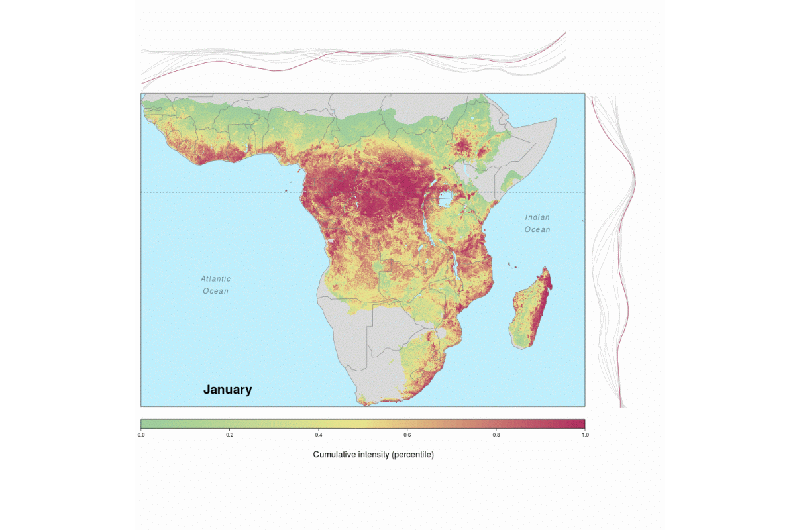New model maps likelihood of Ebola spillovers

Ecologists at the University of Georgia have developed a model that maps the likelihood of Ebola virus "spillovers"-when the virus jumps from its long-term host to humans or animals such as great apes-across Africa on a month-by-month basis.
Their findings, published recently in the journal Emerging Infectious Diseases, reveal seasonal and regional patterns that could help public health officials decide when and where to target Ebola disease surveillance most effectively.
The model predicts that the risk of a spillover in Central Africa, where most Ebola cases have occurred, remains relatively steady throughout the year. It also predicts that spillovers are possible in West and East Africa, with the level of risk varying depending on the season; in both areas, a spillover is most likely during transitions between dry and rainy periods.
"That's important because before the 2014 epidemic people hadn't really thought of West Africa as a high-risk region at all," said lead author J.P. Schmidt, an assistant research scientist in UGA's Odum School of Ecology. The 2014 epidemic that originated in Guinea, Liberia and Sierra Leone was the worst in history, killing at least 11,325 people, according to the U.S. Centers for Disease Control and Prevention.
"I don't think people generally think of East Africa as at risk either, but what our results show is that for some months of the year East Africa may indeed be at significant risk," Schmidt said.
To generate their predictions, Schmidt and his colleagues created a statistical model based on information about environmental conditions associated with known Ebola spillover events.
The researchers started by gathering information about the dates and locations of all known Ebola spillovers from across Africa since the disease was first identified, taking care to verify that each report was credible. They then compiled data about variables such as human population, vegetation and weather conditions over the same time period for sub-Saharan Africa, where the species considered likeliest to serve as Ebola reservoirs are found.
Schmidt developed a library of models that compared population and environmental conditions associated with the known Ebola spillover events to those of 100,000 random date/location combinations across the same time period and geographic region. This analysis revealed that variables associated with climate and seasonality were the most predictive of Ebola spillovers.
"In our models, human population was not a very important predictor," Schmidt said. "It may be important for whether an outbreak takes off and kills a lot of people, but it didn't tell us much about where a spillover was likely to occur, whereas climate and seasonality were really, really important."
The results showed that the risk of Ebola spillover peaks in central Africa, but is also high in certain areas previously not considered at great risk-including the tropical and subtropical forest and woodland regions of Ethiopia, Angola, Zambia, East Africa and Madagascar-during months with intermediate rainfall amounts.
Schmidt cautioned that spillover likelihood does not mean that an epidemic is certain to occur, or indicate anything about its severity if it does.
"It's also logical to assume we've underestimated the spillover risk," Schmidt said. "While we're confident that all the Ebola spillover points in our model are accurate, there may be others we don't know about because they occurred in remote locations or were misidentified."
The researchers hope to build on the model to develop a real-time disease forecasting system, like those used by meteorologists to predict hurricanes.
"We'd like to be able to say, for instance, that these are the conditions that we see in the months prior to when a spillover happened, so if you're in this place and you're having these conditions, then there's a higher than normal likelihood of a spillover next month," Schmidt said.
More information: John Paul Schmidt et al. Spatiotemporal Fluctuations and Triggers of Ebola Virus Spillover, Emerging Infectious Diseases (2017). DOI: 10.3201/eid2303.160101

















